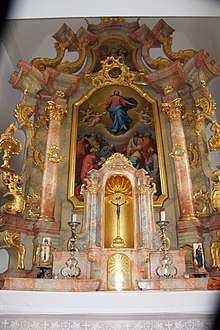Assumption of Mary (Hohenkemnath)
The Roman Catholic parish church of the Assumption of Mary of Hohenkemnath emerged from the castle church of the noble Hohenkemnath estate . The old bell tower of the church is under monument protection (monument protection number D-3-71-154-24), the nave is a new building from 1968.
history
In the oldest parish register of the diocese of Regensburg from 1286 Hohenkemnath is mentioned as a parish. It is assumed that it was a separate church of the Lords of Kemnath, which developed from a castle chaplaincy between 1350 and 1412. In 1412, Johannes, called Amann, is the first pastor to have come down to us. In 1433 Hohenkemnath appeared as an independent parish.
During the turmoil of the Reformation , Hohenkemnath also made several changes of religion. In 1556 the Catholic priest had to give way to a Lutheran and then a Calvinist . During a visitation , the pastor was conspicuous for his great ignorance about the Protestant faith; it was recommended that he be recalled from here and transferred to a smaller parish.
In the 16th and 17th centuries had the right of presentation of the Bishop of Regensburg , this went over to the respective owners of the chateau. At the beginning of the Counter Reformation , the Bishop of Regensburg Albert presented the new Catholic clergyman Blasius Lorenz. On October 9, 1626, the last Calvinist pastor had to leave Hohenkemnath. The pastor lived temporarily in Ammerthal , while the school teacher (also sacristan) lived in the Hohenkemnath rectory. This is how Pastor Blasius Lorenz calls himself Pastor of Ammerthal and then of Hohenkemnath. In 1687 Pastor Paul Kramer moved to the new Hohenkemnath parish, which was connected to the former Erlheim parish.
In the 18th century belonged to Hohenkemnath the branches Bittenbrunn, Erlheim ( Oriliheim , altbaierisch Orili , Garsdorf, Sauheim and Zant) (now all districts of Ursensollen ).
During the secularization in 1800 the church had to hand over a silver statue of Christ, a chalice and a missal wrapped in silver. Pastor Luster bought the chalice and missal back again.
Construction
It can be assumed that the sacristy , which was demolished in 1968, was the original palace chapel. In 1968 the parish church was rebuilt. In place of the demolished sacristy, the nave was added to the high, massive church tower. This is with a lantern - onion topped and was formerly with tinplate covered, 1817, he was charged with shingles covered, now he's back verblecht.
Today's church is a tent-like new building, built in 1968 under Pastor Josef Lobinger, and stands on the site where the castle chapel of the Lords of Kemnath once stood. The new church was consecrated on October 26, 1969 by Auxiliary Bishop Karl Flügel . The sober looking building was designed by architect Josef Alfred Frank from Schwandorf . A found during the new building basement, probably the ossuary of the church was to communicate without the Heritage Institute, abandoned.
A cemetery previously located around the church had to be created outside the village in 1811, and a school garden with a tree nursery was created around the church in 1856. In 1960 a funeral hall was built at the cemetery. The old rectory from 1828 was demolished in 1963 under pastor Josef Kastner and replaced by a new one.
Interior
In 1864/1865 the lord of Podewils had three altarpieces repainted, these were the depiction of the Assumption in the main altar and St. Joseph on the left and St. Sebastian on the right . A new carved Way of the Cross in the Nazarene style was also made, which is now in the new church. In the tower there is a rococo altar with columns and curved struts from the mid-18th century. A Romanesque font from around 1200 is still in use today it consists of a hemispherical basin with a round arch frieze on the edge, on a short round base.
organ
In 1735 the church received an organ , built by the Amberg organ builder Funtsch . This had eight registers and three bellows. On March 22nd, 1990, a new organ was inaugurated by the organ building company Reinhard Weise from Plattling .
Bells
On July 30, 1874, the last of the four bells were installed, which had been removed due to the emergency of the state in 1799 and 1800. The large "women's bell" weighed 14 quintals, the "Donatus bell" 7 quintals, the "St. Josefsglocke "3 ½ quintals and the" Herz-Jesu-Glocke "1 quintal and 75 pounds. During the Second World War , the bells were melted down for war purposes. On May 4th 1950 the current bells were raised on the tower.
literature
- Sixtus Lampl : Monuments in Bavaria - ensembles, architectural monuments, archaeological site monuments: Volume III. Upper Palatinate. Bavarian State Office for Monument Preservation (Ed.) Munich 1985.
- Josef Schmaußer: Hohenkemnath. Historical, church and school outline. In: Amberg information. January 1991, pp. 19-25.
Web links
- Hohenkemnath on aerial photo Laumer
- Bells ringing of the Church of the Assumption in Hohenkemnath in the Upper Palatinate. Bavarian radio
Individual evidence
- ↑ 50 years of the new parish church “Mariä Himmelfahrt” in Hohenkemnath - (not) a reason to celebrate (?)! On Onetz , accessed May 30, 2020.
Coordinates: 49 ° 23 ′ 47.7 " N , 11 ° 46 ′ 51.3" E

